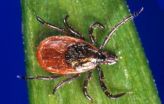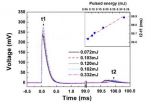(Press-News.org) Researchers at Johns Hopkins Bayview Medical Center used two relatively simple tactics to significantly reduce the number of unnecessary blood tests to assess symptoms of heart attack and chest pain and to achieve a large decrease in patient charges.
The team provided information and education to physicians about proven testing guidelines and made changes to the computerized provider order entry system at the medical center, part of the Johns Hopkins Health System. The guidelines call for more limited use of blood tests for so-called cardiac biomarkers. A year after implementation, the guidelines saved the medical center an estimated $1.25 million in laboratory charges.
In this case, part of the focus was on tests to assess levels of troponin, a protein whose components increase in the blood when heart muscle is damaged. Frequently, troponin tests are repeated four or more times in a 24-hour period, which studies have suggested is excessive, and they are often done along with tests for other biomarkers that are redundant.
In a report published June 28 in the Journal of General Internal Medicine, the research team describes how these interventions reduced overuse of troponin and other biomarker testing without compromising patient care. If adopted widely, the team says, cost savings could be substantial.
"This study has broader implications for the health care system, as most hospitals continue to redundantly test people for chest pain and other symptoms," says report author Jeffrey C. Trost, M.D., an assistant professor of medicine, director of the cardiac catheterization laboratory and co-director of interventional cardiology at Johns Hopkins Bayview Medical Center. "Implementing our interventions could save patients and society a significant amount of money, potentially several billion dollars."
For the study, the Johns Hopkins team set out to lower the rate at which doctors order cardiac biomarker testing for the diagnosis of acute coronary syndrome by basing the desired rate on scientific evidence.
In 2010, the researchers report, more than 17 million patients with chest pain visiting an emergency department in the United States received cardiac biomarker testing.
Between August and October 2011 at Johns Hopkins Bayview Medical Center, the team introduced written institutional guideline and changes to the computerized provider order entry system designed to reduce redundant testing.
The new guidelines suggest ordering troponin alone, without creatine kinase or creatine kinase-MB, for patients suspected to have acute coronary syndrome. It specifies that troponin should be assessed no more than three times over 18 to 24 hours.
Internists and emergency department doctors attended informational sessions to learn the guidelines, and all received quick reference cards summarizing them.
In the computerized provider order entry system, orders for creatine kinase and creatine kinase-MB were removed from all standardized order sets. Troponin orders were removed from all order sets, except two that are used for evaluating new acute coronary syndrome symptoms. A pop-up warning alerted providers when a troponin test was ordered sooner than six hours after a previous one, or when a provider attempted to order creatine kinase or creatine kinase-MB at the same time.
Twelve months after the interventions, doctors' use of the new guidelines increased from 57.1 percent to 95.5 percent and led to a 66 percent decrease in the absolute number of tests ordered. Also, there was a small but statistically significant increase in the primary or secondary diagnosis of acute coronary syndrome after the intervention period.
Lead author Marc R. Larochelle, M.D., an internal medicine resident at Johns Hopkins Bayview Medical Center during the study and now a fellow in general medicine at Harvard Medical School, says that, "Through review of available evidence and reflection on our own practice, I believe we can proactively identify many practices that may be unnecessary and wasteful. We have demonstrated proof of concept that doctors can be leaders in delivering improved value for our patients and health care systems."
Larochelle and Trost believe that provider education and changes to the ordering system were effective in aligning physician ordering behavior with evidence-based guidelines and reducing wasteful health care spending.
The full report is titled "Reducing Excess Cardiac Biomarker Testing at an Academic Medical Center."
INFORMATION:
Other authors of the report are Amy M. Knight, M.D., Hardin Pantle, M.D., and Stefan Riedel, M.D., Ph.D., from Johns Hopkins Bayview Medical Center.
This work was supported by a Putting the Charter Into Practice Grant from the American Board of Internal Medicine Foundation. Larochelle's work was supported by the Health Resources and Services Administration (T32 HP10251, T32 HP12706), the Ryoichi Sasakawa Young Leaders Fellowship Fund and the Harvard Pilgrim Health Care Institute.
Johns Hopkins Bayview Medical Center, located in Baltimore, Maryland, is a full-service, Joint Commission-accredited academic medical center. Among the wide range of services offered are an area wide trauma center and the state's only regional adult burn center. Founded in 1773, our 565-bed facility features several centers of excellence, including stroke, geriatrics, joint replacement, wound care and bariatrics. As part of the Johns Hopkins Health System, our physicians hold full-time faculty positions at the Johns Hopkins University School of Medicine. For more information, visit http://www.hopkinsmedicine.org/jhbmc.
Media contact: Karen Tong
410-550-0128; ktong4@jhmi.edu
June 30, 2014
Efforts to cut unnecessary blood testing bring major decreases in health care spending
2014-07-01
ELSE PRESS RELEASES FROM THIS DATE:
Separating finely mixed oil and water
2014-07-01
CAMBRIDGE, Mass-- Whenever there is a major spill of oil into water, the two tend to mix into a suspension of tiny droplets, called an emulsion, that is extremely hard to separate — and that can cause severe damage to ecosystems. But MIT researchers have discovered a new, inexpensive way of getting the two fluids apart again.
Their newly developed membrane could be manufactured at industrial scale, and could process large quantities of the finely mixed materials back into pure oil and water. The process is described in the journal Scientific Reports by MIT professor Kripa ...
Mayo Clinic researchers reveal treasure trove of genes key to kidney cancer
2014-07-01
JACKSONVILLE, Fla. — A genomic analysis of clear cell renal cell carcinoma (ccRCC), the most common form of kidney cancer, from 72 patients has uncovered 31 genes that are key to development, growth and spread of the cancer, say researchers from Mayo Clinic in Florida. Eight of these genes had not been previously linked to kidney cancer, and six other genes were never known to be involved in any form of cancer.
MULTIMEDIA ALERT: Video and audio are available for download on the Mayo Clinic News Network.
Their study, in the journal Oncotarget, is the most extensive analysis ...
Alcohol use disorders linked to decreased 'work trajectory'
2014-07-01
July 1, 2014 - John D. Meyer, MD, MPH, of Icahn-Mount Sinai School of Medicine, New York, and Miriam Mutambudzi, PhD, MPH, of Johns Hopkins School of Medicine, Baltimore, studied the relationship between occupation and AUDs in workers followed up from early adulthood to middle age. The study focused on the "substantive complexity" of work as an indicator of work trajectory—whether individuals were progressing in their careers in terms of factors such as decision latitude and expanded work abilities.
Based on factors such as drinking more than intended or unsuccessful ...
NIH study reveals gene critical to the early development of cilia
2014-07-01
Researchers at the National Eye Institute (NEI) have described the functions of a gene responsible for anchoring cilia – sensory hair-like extensions present on almost every cell of the body. They show in a mouse model that without the gene Cc2d2a, cilia throughout the body failed to grow, and the mice died during the embryonic stage. The finding adds to an expanding body of knowledge about ciliopathies, a class of genetic disorders that result from defects in the structure or function of cilia. NEI is part of the National Institutes of Health.
The findings are published ...
Smartphone app may revolutionize mental health treatment
2014-07-01
Mental illness accounts for 90 percent of all reported suicides and places the largest burden of any disease on social and economic infrastructures worldwide, according to the World Health Organization. There is a dire need for support services to assist clinicians in the evaluation and treatment of those suffering from mental illness.
New technology developed by researchers at Tel Aviv University is poised to transform the way in which patients with mental illnesses are monitored and treated by clinicians. Dr. Uri Nevo, research team engineer Keren Sela, and scientists ...
Muscle-powered bio-bots walk on command
2014-07-01
Engineers at the University of Illinois at Urbana-Champaign demonstrated a class of walking "bio-bots" powered by muscle cells and controlled with electrical pulses, giving researchers unprecedented command over their function. The group published its work in the online early edition of Proceedings of the National Academy of Science.
"Biological actuation driven by cells is a fundamental need for any kind of biological machine you want to build," said study leader Rashid Bashir, Abel Bliss Professor and head of bioengineering at the U. of I. "We're trying to integrate ...
Reducing deer populations may reduce risk of Lyme disease
2014-07-01
Since white-tailed deer serve as the primary host for the adult blacklegged tick (Ixodes scapularis) — the vector for Lyme disease — scientists have wondered whether reducing the number of deer in a given area would also mean fewer cases of Lyme disease. Now, after a 13-year study was conducted, researchers in Connecticut have found that reduced deer populations can indeed lead to a reduction in Lyme disease cases. The results of their study are published in the Journal of Medical Entomology .
The researchers surveyed 90% of all permanent residents in a Connecticut ...
Enlightening cancer cells
2014-07-01
This news release is available in German.
Harald Janovjak, Assistant Professor at IST Austria, together with Michael Grusch, Associate Professor at the Institute of Cancer Research of the Medical University of Vienna, "remote-controlled" the behaviour of cancer cells with light, as reported this week in EMBO Journal (DOI: 10.15252/embj.201387695). This work is the first application of the new field of optogenetics to cancer research.
To understand the dynamics of cellular signaling, researchers need to activate and inactivate membrane receptor proteins, which ...
A new method to detect infrared energy using a nanoporous ZnO/n-Si photodetector
2014-07-01
Experiments aimed at devising new types of photodetectors have been triggered by the increasing use of optoelectronic devices in personal electronics, cameras, medical equipment, computers and by the military. Professor Zhao Kun and co-researchers at the State Key Laboratory of Petroleum Resource and Prospecting, part of the China University of Petroleum in Beijing, have proposed a new type of infrared photodetector.
Photodetectors, which can convert photons to electrical signals, are used to observe and measure the wavelength or energy of light, including infrared light, ...
Drink walkers do it because their mates think it's okay: QUT study
2014-07-01
Friends may be the key to stopping their mates drink walking, a risky behaviour that kills on average two Australians every week, a QUT study has found.
Researcher Dr Ioni Lewis, from QUT's Centre for Accident Research & Road Safety - Queensland (CARRS-Q), said in a survey of young people aged 17 to 25, friends were the strongest influence on their intentions to drink walk.
"Drink walking, or walking while intoxicated in a public place, is linked to increased risk of injury and fatality," Dr Lewis said.
In a survey, published in Transportation Research, more than ...



